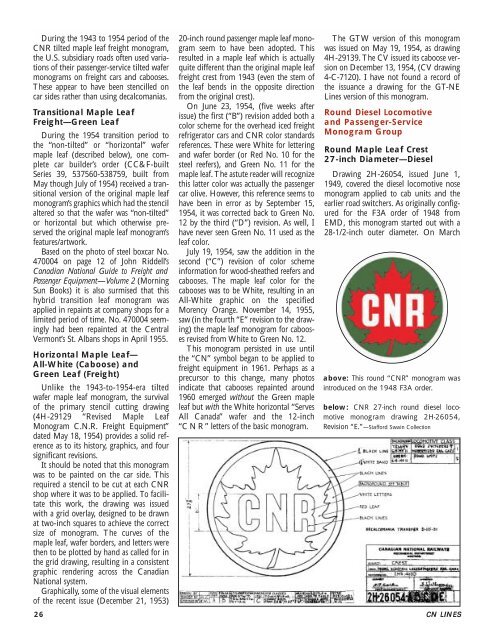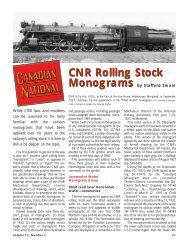CN LINES V12N3 - Canadian National Railways Historical Association
CN LINES V12N3 - Canadian National Railways Historical Association
CN LINES V12N3 - Canadian National Railways Historical Association
You also want an ePaper? Increase the reach of your titles
YUMPU automatically turns print PDFs into web optimized ePapers that Google loves.
During the 1943 to 1954 period of the<br />
<strong>CN</strong>R tilted maple leaf freight monogram,<br />
the U.S. subsidiary roads often used variations<br />
of their passenger-service tilted wafer<br />
monograms on freight cars and cabooses.<br />
These appear to have been stencilled on<br />
car sides rather than using decalcomanias.<br />
Transitional Maple Leaf<br />
Freight—Green Leaf<br />
During the 1954 transition period to<br />
the “non-tilted” or “horizontal” wafer<br />
maple leaf (described below), one complete<br />
car builder’s order (CC&F-built<br />
Series 39, 537560-538759, built from<br />
May though July of 1954) received a transitional<br />
version of the original maple leaf<br />
monogram’s graphics which had the stencil<br />
altered so that the wafer was “non-tilted”<br />
or horizontal but which otherwise preserved<br />
the original maple leaf monogram’s<br />
features/artwork.<br />
Based on the photo of steel boxcar No.<br />
470004 on page 12 of John Riddell’s<br />
<strong>Canadian</strong> <strong>National</strong> Guide to Freight and<br />
Passenger Equipment—Volume 2 (Morning<br />
Sun Books) it is also surmised that this<br />
hybrid transition leaf monogram was<br />
applied in repaints at company shops for a<br />
limited period of time. No. 470004 seemingly<br />
had been repainted at the Central<br />
Vermont’s St. Albans shops in April 1955.<br />
Horizontal Maple Leaf—<br />
All-White (Caboose) and<br />
Green Leaf (Freight)<br />
Unlike the 1943-to-1954-era tilted<br />
wafer maple leaf monogram, the survival<br />
of the primary stencil cutting drawing<br />
(4H-29129 “Revised Maple Leaf<br />
Monogram C.N.R. Freight Equipment”<br />
dated May 18, 1954) provides a solid reference<br />
as to its history, graphics, and four<br />
significant revisions.<br />
It should be noted that this monogram<br />
was to be painted on the car side. This<br />
required a stencil to be cut at each <strong>CN</strong>R<br />
shop where it was to be applied. To facilitate<br />
this work, the drawing was issued<br />
with a grid overlay, designed to be drawn<br />
at two-inch squares to achieve the correct<br />
size of monogram. The curves of the<br />
maple leaf, wafer borders, and letters were<br />
then to be plotted by hand as called for in<br />
the grid drawing, resulting in a consistent<br />
graphic rendering across the <strong>Canadian</strong><br />
<strong>National</strong> system.<br />
Graphically, some of the visual elements<br />
of the recent issue (December 21, 1953)<br />
20-inch round passenger maple leaf monogram<br />
seem to have been adopted. This<br />
resulted in a maple leaf which is actually<br />
quite different than the original maple leaf<br />
freight crest from 1943 (even the stem of<br />
the leaf bends in the opposite direction<br />
from the original crest).<br />
On June 23, 1954, (five weeks after<br />
issue) the first (“B”) revision added both a<br />
color scheme for the overhead iced freight<br />
refrigerator cars and <strong>CN</strong>R color standards<br />
references. These were White for lettering<br />
and wafer border (or Red No. 10 for the<br />
steel reefers), and Green No. 11 for the<br />
maple leaf. The astute reader will recognize<br />
this latter color was actually the passenger<br />
car olive. However, this reference seems to<br />
have been in error as by September 15,<br />
1954, it was corrected back to Green No.<br />
12 by the third (“D”) revision. As well, I<br />
have never seen Green No. 11 used as the<br />
leaf color.<br />
July 19, 1954, saw the addition in the<br />
second (“C”) revision of color scheme<br />
information for wood-sheathed reefers and<br />
cabooses. The maple leaf color for the<br />
cabooses was to be White, resulting in an<br />
All-White graphic on the specified<br />
Morency Orange. November 14, 1955,<br />
saw (in the fourth “E” revision to the drawing)<br />
the maple leaf monogram for cabooses<br />
revised from White to Green No. 12.<br />
This monogram persisted in use until<br />
the “<strong>CN</strong>” symbol began to be applied to<br />
freight equipment in 1961. Perhaps as a<br />
precursor to this change, many photos<br />
indicate that cabooses repainted around<br />
1960 emerged without the Green maple<br />
leaf but with the White horizontal “Serves<br />
All Canada” wafer and the 12-inch<br />
“C N R ” letters of the basic monogram.<br />
The GTW version of this monogram<br />
was issued on May 19, 1954, as drawing<br />
4H-29139. The CV issued its caboose version<br />
on December 13, 1954, (CV drawing<br />
4-C-7120). I have not found a record of<br />
the issuance a drawing for the GT-NE<br />
Lines version of this monogram.<br />
Round Diesel Locomotive<br />
and Passenger-Service<br />
Monogram Group<br />
Round Maple Leaf Crest<br />
27-inch Diameter—Diesel<br />
Drawing 2H-26054, issued June 1,<br />
1949, covered the diesel locomotive nose<br />
monogram applied to cab units and the<br />
earlier road switchers. As originally configured<br />
for the F3A order of 1948 from<br />
EMD, this monogram started out with a<br />
28-1/2-inch outer diameter. On March<br />
above: This round “<strong>CN</strong>R” monogram was<br />
introduced on the 1948 F3A order.<br />
below: <strong>CN</strong>R 27-inch round diesel locomotive<br />
monogram drawing 2H-26054,<br />
Revision “E.”—Stafford Swain Collection<br />
26 <strong>CN</strong> <strong>LINES</strong>



